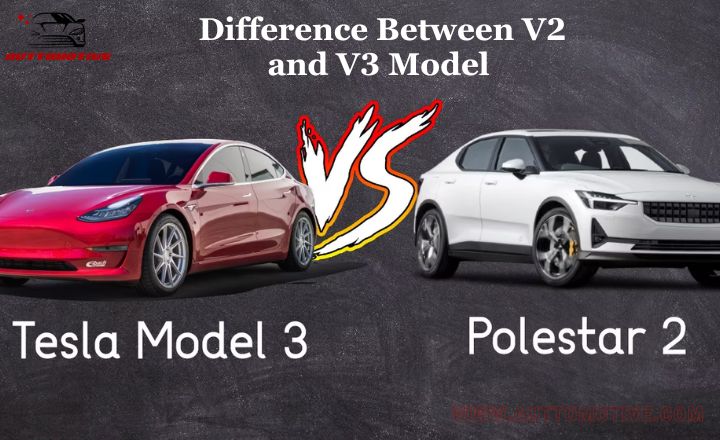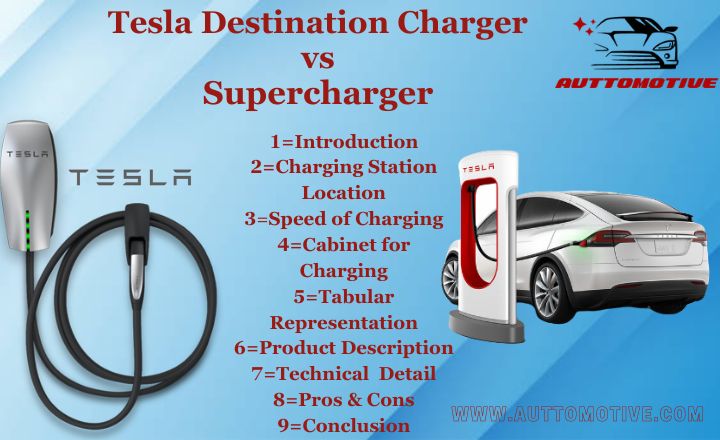Tesla’s Destination Chargers are becoming more popular with every new Tesla release. They are designed to let drivers charge their cars at hotels, restaurants, and other commercial locations. Superchargers are Tesla’s primary charging method, allowing drivers to charge their cars quickly at designated stations.
We will examine the different points of the Tesla Destination Charger vs Supercharger. Which is the best way to charge your Tesla?
Tesla Destination Charger vs Supercharger
Are you a Tesla owner looking for the perfect charging station? Look no further than the Tesla Destination Charger and Supercharger. While both options are designed to charge your vehicle quickly and efficiently, they have some key differences that may affect your decision. Let’s talk location. (Read detail About GPS System )Tesla Destination Chargers can be found at various hotels, restaurants, and shopping canters.
It makes them perfect for those looking to charge their car while taking a break during a road trip or grabbing a bite to eat. Superchargers are typically located along major highways and interstates – making them ideal for long-distance travel.
Next up are fees. The great news is that both options are free to use! It’s important to note that some businesses offering destination chargers may require you to purchase access to the charger.
After these, Some more points, like the cabinet for the charger and charging speed, are also will discuss in this blog.
Charging Station Location
Electric vehicles are becoming increasingly popular, and for a good reason. They’re eco-friendly, quiet, and packed with features that make driving a joy. The major concern EV drivers have where to charge their vehicles. The charging station location is crucial in determining the convenience of owning an electric car.

Tesla charging stations, there are two main options: destination chargers and superchargers. Destination chargers are located at hotels, restaurants, or other public places where you can park your car while enjoying your stay. These chargers offer slower charging rates than superchargers but are more conveniently located around town.
Superchargers provide fast charging for long-distance travel.
Speed of Charging
In Electric vehicles, charging time is a crucial factor for drivers. Both options (Super and Destination) provide convenience and accessibility for Tesla owners on the go, but there are some key differences between the two. Let’s talk about the speed of charging. Superchargers are designed to charge at high speeds, with an average charge rate of 170 miles in just 30 minutes. It makes them ideal for long road trips or when you must quickly top off your battery.
Destination chargers offer a slower but effective charge rate of around 25 miles per hour. These chargers are typically found at hotels, restaurants or shopping centers where you can plug in your car while you run errands or grab a meal.
Cabinet for Charging
The Cabinet for Charging – the ultimate solution for all your Tesla charging needs. Equipped with Superchargers specifically designed for urban V2 and V3 models, this powerful 72kw gadget can charge automobiles at an impressive 19.2 kW. Gone are the days of waiting around at slow charging stations – with the Cabinet for Charging, you’ll be back on the road in no time.
But how does it compare to other charging options available to Tesla owners? When it comes to choosing between a Tesla Destination Charger and a Supercharger like the Cabinet for Charging, it ultimately depends on your specific needs.
Difference Between V2 and V3 Model
The V2 and V3 models of charging cabinets are the future of charging technology. The notable feature of these models is their unique cable connector design. The cable connector on the V2 model is lighter than other charging cabinets, making it sturdier for safety reasons. Users can trust that their devices will not fall out or become damaged while they charge.
The V3 model takes things a step further by introducing liquid-cooled connectors. It helps to regulate temperature during the charging process and ensures that your devices remain safe from overheating or short-circuiting. This feature helps increase the lifespan of your device’s battery by reducing heat-based wear and tear over time.
If you are looking for a reliable and efficient cabinet for charging your devices, look no further than the V2 and V3 models. Must Read About Tesla Model 3.

Charging Fees
As we know about speed, Superchargers are high-speed chargers that can provide up to 170 miles of range in just 30 minutes. They are strategically located along major highways and interstates, making them ideal for long-distance travel. Superchargers come with a cost – a per kWh fee that varies depending on location and Tesla models. While they may be a great option for road trips, regular use can add up quickly.
Destination Chargers are typically located at hotels, restaurants, and other businesses where Tesla drivers may want to stop and spend some time. These chargers offer slower charging speeds but are often free for customers or guests.
Destination vs Supercharger: Tabular Representation
Tesla has established a distinct set of differences resulting from both the Tesla destination charger and the Supercharger. See Table
| Tesla destination charger | Supercharger |
| Destination Chargers take longer to process your vehicle. | Superchargers charge your Tesla much more quickly. |
| Destination Chargers, on either hand, are frequently free since you’re already paying for other service facilities. | You must pay for charging whenever your credit has been depleted. |
| Destination Chargers are often found in metropolitan locations like shops and resorts. | Superchargers are frequently seen on roads since they’re meant to get you back on the road as soon as reasonably practicable. |
| Destination Chargers, on either hand, employ Tesla’s Grid Connector. It’s a 240-volt gadget that can charge automobiles at 19.2 kW. | Superchargers come in diverse shapes and sizes and charge cars at varying rates. They offer Superchargers for the Urban, V2, and V3 models. |
Destination Charger:
Pros
- Can charge multiple vehicles at the same time
- Has a high wattage
- It is convenient to use
Cons
- It may be expensive to purchase
Supercharger:
Pros
- Increases power and performance
- Faster fuel economy
- Increased range
Cons
- Requires installation by a skilled technician
- Expensive
Some Types of Destination Charger
1=Tesla Wall Connector – Discontinued Model

Product Description
Tesla Wall Connector
The Tesla Wall Connector was designed for the Model S, Model X, and Model 3 electric vehicles. It allowed drivers to charge their cars up to 50 per cent faster than they could with the Mobile Connector with NEMA.
It became a popular choice among Tesla owners who wanted to maximize their charging speed without relying on superchargers or third-party charging stations. Despite its discontinuation, there are still plenty of options available for Tesla owners who want fast and reliable home charging solutions.
Customizable Power
With customizable power settings, Tesla owners can maximize their charge rate wherever they park.
Not only does this feature enhance convenience, but it also helps reduce wait times at charging stations for those making long-distance trips. These customizable power settings work indoors or outdoors and provide flexibility for those needing access to a traditional garage or driveway.
Automatically Distributing Power
Wall Connectors that can distribute power automatically among multiple vehicles are becoming more widely available from third-party manufacturers. These devices use load-balancing technology to ensure that each car gets equal power, even when multiple vehicles are plugged in at once.
It maximizes existing electrical capacity, saves time, and makes it easier for families or businesses with multiple electric vehicles to keep them up and ready to go.
Technical Details
| Brand | Tesla |
| Connector Type | Auxiliary |
| Compatible Devices | Charging Adapter |
| Connector Gender | Male-to-Male |
| Number of Items | 1 |
| Wattage | 11.5 KW |
| Item Weight | 14.32 pounds |
| Package Dimensions | 19.92 x 15.04 x 5.28 inches |
| Item model number | Tesla Gen 3 |
| Manufacturer Part Number | Tesla Gen 3 |
*Legal Disclaimer
48 Amp 11KW fast GEN3 Charger for Model 3 Y S X Charge your battery from zero to 100 percent in as little as seven hours
2= Charge Point Home Flex Electric Vehicle (EV) Charger

Product Detail
| Brand | Charge Point |
| Connectivity Technology | Wi-Fi |
| Cover Included | Charging Station and Cable |
| Special Feature | Travel |
| Color | Black |
| Input Voltage | 240 Volts |
| Model Home | Flex |
| Item Weight | 17.6 pounds |
| Country of Origin | Mexico |
| Item model number | Home Flex Electric Vehicle (EV) Charger |
| Manufacturer Part Number | CPH50-NEMA14-50-L23 |
| Amperage | 50 Amps |
| Voltage | 240 Volts |
| Total USB Ports | 2 |
| Number of Items | 1 |
| Power Source | Corded Electric |
Product Description
Flexibility:
The best part about this charging system is its flexibility. With five different power level options – 16, 24, 32, 40 and 48 amps – you can choose the best level that suits your needs. That means if you have a smaller battery requiring less time to charge, you can select a lower power level and save money on electricity costs.
Wi-fi connected and charging schedule ability.
The Wi-Fi-enabled feature allows users to access their charging data remotely through the Charge Point app on their smartphones or tablets. It means you can easily monitor your usage, view your charging history, and track your expenses, all from the comfort of your home or office.
This feature also enables remote software updates that ensure your charger stays up-to-date with new features and enhancements. Charge Point is the ability to set a custom charging schedule.
ENERGY STAR-Certified
The Charge Point Home Flex Electric Vehicle (EV) Charge is an ENERGY STAR-certified charging station designed to charge your EV at home. This innovative charging system is compatible with all types of electric vehicles and can be easily installed in your garage or driveway.
The Home Flex Electric Vehicle Charge comes with a range of features, including choosing between a NEMA 14-50 or 6-50 plug, making it adaptable to different types of outlets.
With the Home Flex Electric Vehicle Charge, you’ll enjoy fast and reliable charging for your electric vehicle. It can deliver up to 50 amps of power, which means you can get a full charge in as little as four hours. You’ll also appreciate the convenience of monitoring your charging progress via the Charge Point app on your smartphone.
In Closing
As we Read bout chargers in Upper Blog, Tesla Destination Charger vs Supercharger are great ways to charge your car. They have pros and cons, but it comes down to personal preference. If you’re looking for a quick way to charge your car, the Supercharger is the way to go.
The Tesla Destination Charger is perfect if you’re looking for a more permanent solution.
Either way, both options are worth considering!
FAQs
What’s the Distinction Between a Level 1 Charger and a Level 2 Charger?
A Level 1 is a low-power charger that can only charge small devices, like smartphones. A Level 2 charger is a high-power charger that can also charge larger devices, like tablets.
Where can I find a Supercharger station?
There are a few Supercharger stations scattered around the United States. The best way to find one is to use the Supercharger Finder tool on the Tesla website.
Where can I find Destination Chargers?
There are a few places you can find destination chargers. Many hotels have them in the room and some restaurants near the entrance. You can also find them at public charging stations.
What are the distinctions between Tesla Superchargers and Destination Chargers?
Tesla Superchargers are a type of destination charger that provides a high-speed charging experience for Tesla vehicles.
Destination chargers are typically located near businesses and other places where drivers may want to stop for a quick recharge.

